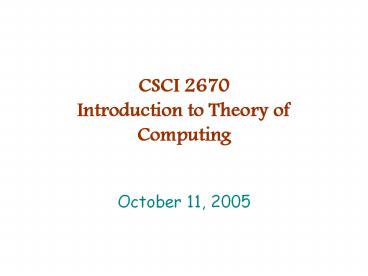CSCI%202670%20Introduction%20to%20Theory%20of%20Computing - PowerPoint PPT Presentation
Title:
CSCI%202670%20Introduction%20to%20Theory%20of%20Computing
Description:
... by Turing machines Inputs can be represented as strings Graphs Polynomials Atomata Etc. Example algorithm Depth-first ... right Recursive algorithm ... Every time ... – PowerPoint PPT presentation
Number of Views:144
Avg rating:3.0/5.0
Title: CSCI%202670%20Introduction%20to%20Theory%20of%20Computing
1
CSCI 2670Introduction to Theory of Computing
October 11, 2005
2
Agenda
- Last week
- Prove equivalence of deterministic and
nondeterministic Turing machines - Today
- Enumerators
- Definition of algorithm
- Another class of languages
- Decidable
3
Announcements
- Quiz tomorrow
- High-level description of TM
- Trace through a TMs operation
- Tape notation configuration notation
- High-level description of equivalences
- Homework due next Tuesday (10/18)
- 4.4, 4.6, 4.7, 4.12, 4.19
- Old text 4.4, 4.7, 4.8, 4.11, 4.19
4
Enumerators
- Instead of reading an input and processing it,
enumerators start with an empty tape and print
out strings in S
5
Machine equivalence
- Theorem A language is Turing-recognizable if
and only of some enumerator enumerates it. - Proof technique Construction in each direction
6
TM accept enumerator language
- TM On input w
- Run enumerator E. Every time E prints a string,
compare it to w. - If w appears in the output, accept.
7
Enumerator accepts TM language
- Let s1, s2, s3, be all the strings in S
- E Ignore the input.
- For i 1, 2, 3,
- Run M for i steps on each input s1, s2, , si
- Whenever M accepts a string, print it
8
What is an algorithm?
- Intuitively, an algorithm is anything that can be
simulated by a Turing machine (Church-Turing
Thesis) - Many algorithms can be simulated by Turing
machines - Inputs can be represented as strings
- Graphs
- Polynomials
- Atomata
- Etc.
9
Example algorithm
- Depth-first walk-through of binary tree
- Which nodes do you visit, and in what order, when
doing a depth-first search? - Visit each leaf node from left to right
- Recursive algorithm
10
Binary tree depth-first walk-through
- Start at root
- Process left subtree (if one exists)
- Process right subtree (if one exists)
- Process how?
- Print the node name
- If there is a left subtree then
- Process the left subtree
- Print the node name again
- If there is a right subtree then
- Process the right subtree
- Print the node name again
11
Example
1
2
4
8
4
2
5
9
5
1
3
6
10
6
3
7
2
12
Can a Turing machine do this?
- Input must be a string (not a tree)
- Can we represent a tree with a string?
- Yes.
13
String representation of a binary tree
14
Can a Turing machine do this?
- Input must be a string (not a tree)
- Can we represent a tree with a string?
- Yes
- How do we know which node(s) are children of
current node - If node is kth node at depth d, its position in
the string is 2dk-1 and its children are at
position 2d12(k-1) and 2d12k-1
15
What about the output?
- Need to write out nodes in a particular order
- Can we do this with a TM?
- Yes. Add output tape
- A TM can move left and right on the input tape
writing to the output tape whenever appropriate
16
Describing Turing machines
- From now on, we can describe Turing machines
algorithmically - M On input w
- 1.
- 2.
17
Decidability
- A language is decidable if some Turing machine
decides it - Not all languages are decidable
- We will see examples of both decidable and
undecidable languages
18
Showing a language is decidable
- Write a decider that decides it
- Must show the decider
- Halts on all inputs
- Accepts w iff w is in the language
- Can use algorithmic description
19
DFA acceptance problem
- Consider the language
- ADFA ltB,wgt B is a DFA that accepts the
string w - Theorem ADFA is a decidable language
- Proof Consider the following TM, M
- M On input string ltB,wgt, where B is a DFA and
w is an input to B - Simulate B on input w
- If simulation ends in accept state, accept.
Otherwise, reject.
20
NFA acceptance problem
- Consider the language
- ANFA ltB,wgt B is a NFA that accepts the
string w - Theorem ANFA is a decidable language
- Proof Consider the following TM, N
- N On input string ltB,wgt
- Convert B to a DFA C
- Run TM M from previous slide on ltC,wgt
- If M accepts, accept. Otherwise, reject.
21
RE acceptance problem
- Consider the language
- AREX ltR,wgt R is an RE that generates the
string w - Theorem AREX is a decidable language
- Proof Consider the following TM, P
- P On input string ltR,wgt
- Convert R to a DFA C using algorithm discussed in
class and in text - Run TM M from earlier slide on ltC,wgt
- If M accepts, accept. Otherwise, reject.































